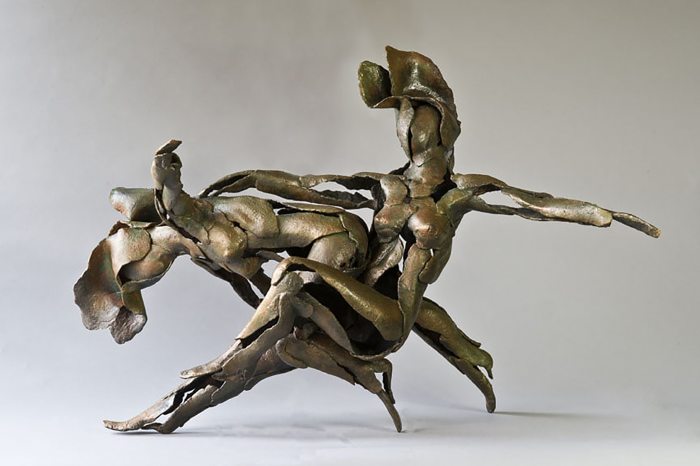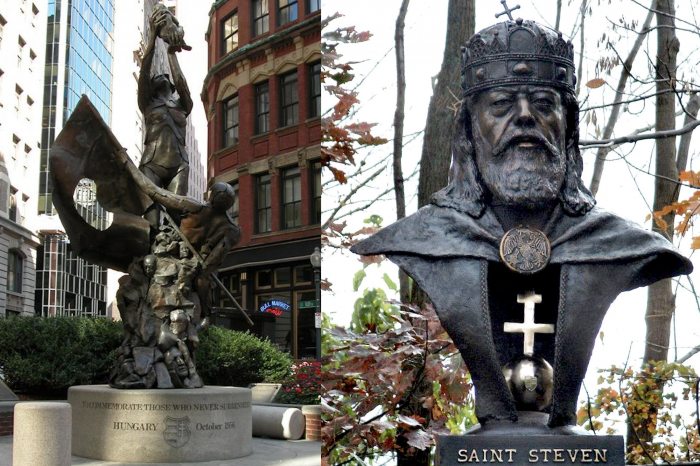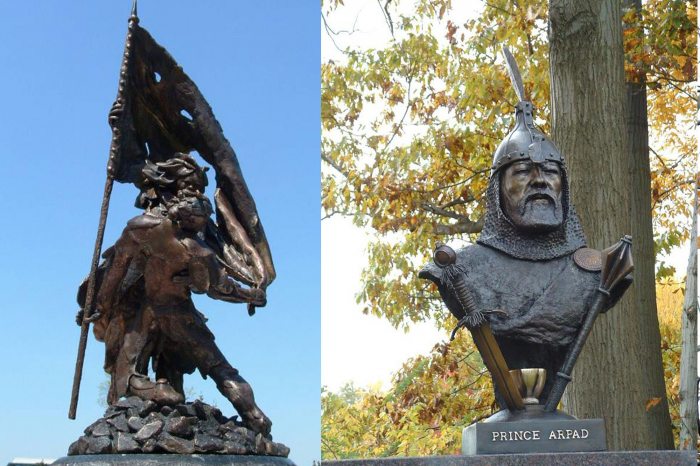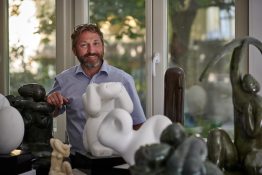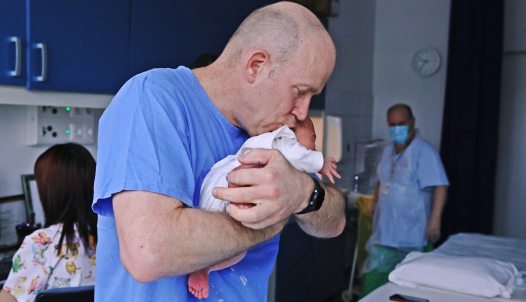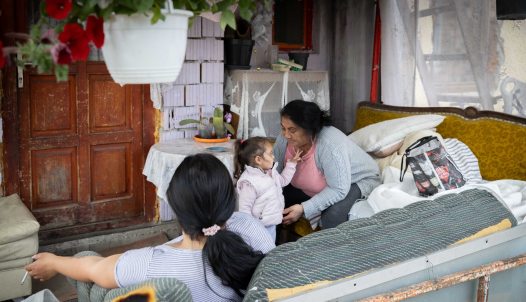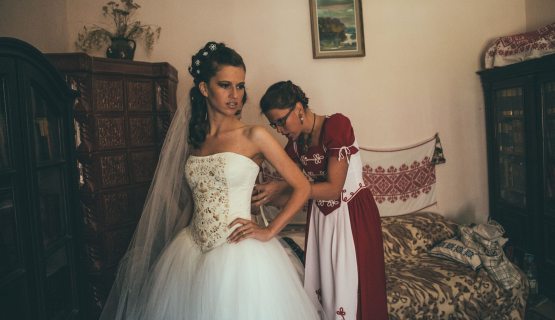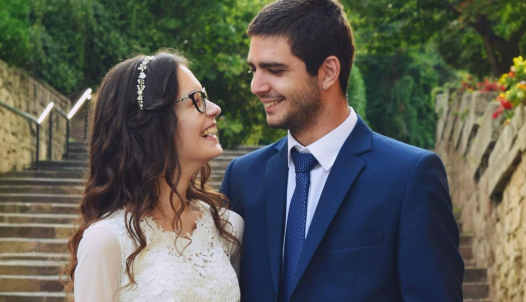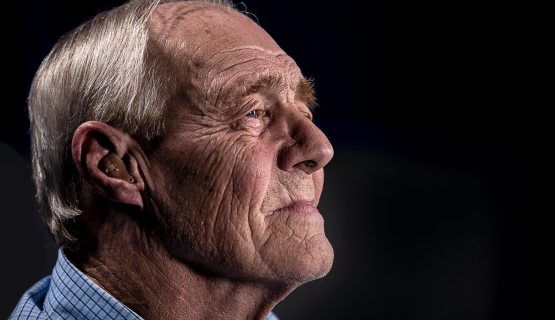"The Hungarian language is music to my ears" – sculptor Gyuri Hollósy takes care of his Hungarian roots in the US
He has never lived in Hungary, yet he speaks our language without an accent, and his Hungarian identity defines his life. Gyuri Hollósy was born in Germany after the Second World War to Hungarian parents with whom he settled in the USA at the age of nine. The sculptor continued the family tradition that made his great-uncles – painters Tivadar Csontváry Kosztka and Simon Hollósy – famous. Among many others, he makes 1956-themed Hungarian sculptures. His studio is decorated with a Hungarian flag and the coat of arms of the Kosztka family. Even his dog (a Puli breed) named Tibor Bartók Csillag is Hungarian. We talked to Gyuri, who lives in New Jersey, about the novel-like life of his ancestors and him, and the message of his works.

– Let's start with the past! What should we know about previous generations of your family?
– One of my great-uncles was Simon Hollósy on my father’s side, Ervin Simon Hollósy. The other was Tivadar Csontváry Kosztka on my mother’s side, Ilona Erzsébet Kosztka. As famous painters, they were my relatives in their artistic way of life, too. The Kosztka family came to Hungary from Poland in the 17-18th century, and the Hollósys came from Transylvania. My father was born in the village of Petrova, from where the Hungarians were expelled after the First World War. My grandfather was a judge, imprisoned by the Romanians but later released to Eger, Hungary to join his relocated family. My mother was born in Recsk, where they had a prestigious orchard; they also received awards for their fruits. I found a large certificate about this, bigger than my paintings, as I paint, too. And I keep everything that reminds me of what the old Hungarian world was like. My grandfather, on my father's side, allegedly gave wonderful speeches and even wrote down the stories of his life on an old typewriter.
Everyone thought these writings were lost, but I found them in the parental house. I remember them because my father read these to me as a child.
I still have them; you can get insight from them about my grandfather’s adventurous life and the historical changes of the early 20th century. I also took a copy of it to my father's siblings in Hungary.
– When and where did your parents get married, and why were you born in Germany?
– They got married in Hungary during the Second World War. My brother, László, was born in 1944, but unfortunately, he died at the age of six months. I was born in 1946 in Germany, where my parents emigrated for political reasons. In Germany, my father became the leading producer and announcer of Radio Free Europe. Since my grandparents stayed at home, my grandfather always wrote to my father whenever he heard him on the radio. Of course, he sent his letters in coded language because they didn’t know who could see their correspondence. When the radio was looking for a child voice for a play, I was even given a role. My father spoke German well and later had perfect English pronunciation, but he couldn’t put the sentences together correctly in English. My mother put them together well, but her pronunciation was funny, so many times, I translated what they said. We stayed in Munich until we received a report in 1955 from the U.S. Consulate that they were going to close the borders for ten years, so if we wanted to emigrate, we needed to go that year. And we went. Then, in 1956, almost 300,000 Hungarians came after us; fortunately, they were accepted as well.
– When you lived in Germany, why did America come into your plans?
– Because my mother's father was already living in Chicago at the time. From the Kosztka family, my great-grandfather was a hussar officer in the 1848 Hungarian revolution. When they lost, he settled in America. He became a citizen and began a new career as a jeweler, then fought there for four years in the Civil War on the side of the North. He hated to see brothers going against brothers and was also upset by the assassination of President Lincoln and the way black people were treated. He did not understand why a distinction was made between human and human, and finally, when amnesty was given by the Habsburg's, he returned home in 1868. My grandfather was born in Hungary, but he became an American citizen through his father, so he was accepted by America immediately after the Second World War. In Germany, we were still hoping that the political situation in Hungary would change, and we could return home, but it did not. Maybe we did better to go in 1955 because my father was the type of man who would have gone home even from Germany to fight in the revolution in 1956. But this way, we could stay together. Dad kept in touch with The Knightly Order of Vitéz in Hungary, but he strictly asked me not to think of going home with the name Hollósy because he feared for his only remaining child.
I was able to travel for the first time after 1989 and since then, I have been to Hungary three times.
– What was your life like in the United States?
– Dad started as a worker, then learned the engineering profession, even though he was a lawyer in Budapest. He planned elevators for buildings, then coal mines, and he stayed with the company even after retirement. In addition, he played music. He mainly played the violin, but he also loved the piano and was even an excellent singer, helping compile the Mindszenty Choir in Cleveland. When Cardinal József Mindszenty came there in person, Dad also sang to him. Mom loved to sew; she made a lot of embroideries. We still keep a lot of her work today; of course, we don’t put it on the table, we just admire them. She had a job in a shop, and they made inscriptions and embroideries on coats.
– What did the family say when you announced that you’d started an artistic career?
– When I had to choose a profession, Grandpa, Grandma, Mom and Dad talked to me. Grandpa suggested that I should be an engineer, and Dad told me to be a doctor or a lawyer, which ensured a good life. So which one do you want? he asked. I said neither; I want to be an artist! Mom alone said: “Since there were artists in the family, accept it, try to help him along this path if he feels he has the same in him.” Dad kept thinking for four days. He was basically a funny, good-natured man, but then he was gloomy for four days. On the fourth day, I said, okay, I give up, what profession should I choose? Then he sat down and said: "If you choose to do that, you're going to have a hard life, there's not a lot of opportunities unless you're very good. But if you believe in it, we believe in you." And with that, my future was decided when I was 14-15 years old.
– What gave you such a strong inspiration for art?
– My parents sent me to a Piarist seminar with other Hungarian immigrant children in the Buffalo area two years earlier.
A new chapel had just been built there, and a priest heated iron, and then with the iron, he drew portraits of saints into wood pillars.
I was looking for a quiet place for myself, so I watched him in the chapel. That smoke, those saints, that sizzling sound and the furnace together… I was so impressed by them that I said: this is what I want to be! Now that I’m telling you about this, I realized something. I haven't drawn since that time, but I’ve been making facial drawings since the epidemic began. The inspiration for them can only come from the priest and the saints! Even today, when my life is hard, I think back to when I was 12, and I already know why I wanted to be an artist. This memory gives me the strength to continue on my way.
– Has it been such a difficult journey as your father predicted?
– Yes, mainly because it took me time to find my own artistic language. I not only wanted to be a painter or a sculptor but also to find my soul at work. For a long time, I didn’t feel like me, and my works were companions; I lacked connection. But when I made the statue of József Mindszenty in 1975 after his death, I heard my own voice. I realized that I like sculpture more than painting because my last line as a painter is the final word. But my sculptures have no closure; you can always see something new in them. It depends on where you look, going closer or moving away, from the same level or looking up at it. And I began to focus on these differences in perspective–play with shapes, with movement. My sculptures have no basis; if you turn them over, they still live, but they give out a different shape. There is no right, left, top or bottom. That’s why dance inspires me, that’s where my movable dance sculptures come from. I make three different figures and then connect them in each version to form even more shapes to express more emotion.
– These sculptures are part of your work. Another part is the Hungarian-themed sculptures.
– I mainly work on Hungarian topics related to 1956. The largest monument of the Hungarian Revolution was erected in Boston in 1989; although it was ready before, the delivery was delayed for technical reasons. Thus, the strange coincidence happened that in the summer of 1989, we handed over the statue in Boston symbolizing the Hungarians’ freedom, and a few months later, Hungary was truly liberated. I didn't just want to show armed people on it but the aspirations of the Hungarians. It depicts a warrior who has almost fallen to the ground, one arm missing, but the other holding the perforated flag and looking up at a woman. The woman is Hungary, and the child in her hands means hope. I patterned the faces of the lads appearing at the monument from my students' faces with whom I’d worked on the statue. I smuggled Mindszenty and even Napoleon's face in, but I didn't tell anyone. I was once my own model for a statue of King St. Stephen I of Hungary and Prince Arpad. (laughs) Later, I made another sculpture for the 50th anniversary of the revolution. The American Hungarians wanted to give it to Budapest, but they didn't find its style modern enough.
I didn’t feel it outdated, though the inspiration really came from a long time ago; it was inspired by the Hungarian poem: Angel from Heaven by Sandor Marai.
In the setting, an angel comes from heaven to the freedom fighter and helps him raise the torn flag. It is still a question of where and when it will be set up, if not in Hungary, then in America.
– Your words are imbued with artistic enthusiasm. Are the others in your family artists, too?
– My 25-year-old daughter, Annalise Simone Hollosy, is also an artist. She mostly deals with animation in California. She was born at 19:13, which is exactly the year my father was born, 1913. That is why she got the name Simone after my father and Annalise after my grandmother. My wife is also a sculptor; she runs the visual arts program at Princeton University's Lewis Center for The Arts. I also used to teach at universities, but now I do my art in my studio, and I am the head chef at home. (laughs) I combine Hungarian and Transylvanian cuisine with Southern Creole and Cajun meals. Sometimes, also with Chinese influences because I am invited to China more often than to Hungary. Last time I went to Pécs for a joint exhibition of Hungarian and Philadelphia sculptors, the interpreter did not come, so I translated. They asked me: when did I leave the country to speak so beautifully? I say, never, I didn't even live here. But in Kecskemét, a lady also remarked that I still speak the old Hungarian, not the new one. My wife and I traveled all over the country in 1993, visiting relatives who were still alive at the time, with whom we also corresponded for a long time.
– Why is it so important for you to take care of your Hungarian heritage while spending your whole life in another part of the world?
– On the one hand, I owe a lot to my artist ancestors, and I am grateful for what I inherited from them. Let me give you an example. I work with both hands, although I was originally left-handed, only then did I learn right. I noticed that my right hand works in more detail, and my left hand is looser, more instinctive. And I once noticed the same difference between Simon Hollósy’s right- and left-handed works. So if, say, I eat soup with my right hand and then involuntarily turn left, something is definitely going through my mind! (laughs) And as for my Hungarian identity, it's not just old relatives who inspire me to take care of it.
I loved my parents so much, I have all the beautiful memories of them and Hungary.
I hope to get there one more time because I promised my daughter to take her, too. But as an artist, it’s hard to travel without an invitation. So being Hungarian is my life, as my father taught me Hungarian. Like my grandfather, he was a good speaker with perfect pronunciation. And since he was also into music, he taught me not only to hear the words but to think that they were musical sounds, and then I could memorize them more easily. Therefore, the Hungarian language is music to my ears!
Heroic marriage proposal
At the end of the conversation, Gyuri told another touching story about his parents:
"The Hollósy and Kosztka families have known each other for a long time. But when Dad, who also completed Ludovika University’s officer training, wanted to marry Mom, my grandfather didn’t allow it. After the war started, my mother's brother, Lieutenant László Kosztka, was killed near the Russian-occupied Kiev. The Hungarians tried to occupy the village where it took place with many attempts, without success. My father asked permission from the command to try it with his unit, and then successfully took control of the area. He found the fallen Hungarian soldiers and buried them in a cemetery next to a Russian church. He took detailed photographs of the military funeral and presented the images to my grandfather. Dad was honored with a Knight’s Order for his act, and my grandfather then gave permission to him to marry my Mom. I am extremely proud of this story!”
